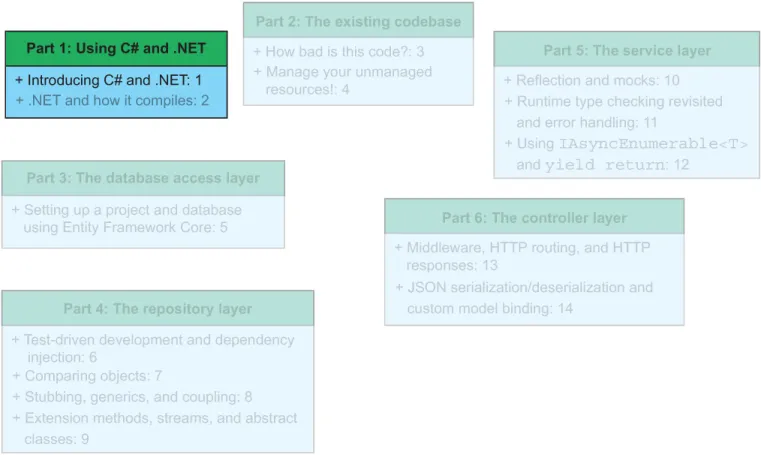
Code like a Pro in C#
Jort Rodenburg
- 416 pagine
- English
- ePUB (disponibile sull'app)
- Disponibile su iOS e Android
Code like a Pro in C#
Jort Rodenburg
Informazioni sul libro
Build on your existing programming skills and upskill to professional-level C# programming. Summary
In Code Like A Pro in C# you will learn: Unit testing and test-driven development
Refactor a legacy.NET codebase
Principles of clean code
Essential backend architecture skills
Query and manipulate databases with LINQ and Entity Framework Core Critical business applications worldwide are written in the versatile C# language and the powerful.NET platform, running on desktops, cloud systems, and Windows or Linux servers. Code Like a Pro in C# makes it easy to turn your existing abilities in C# or another OO language (such as Java) into practical C# mastery. There's no "Hello World" or Computer Science 101 basics—you'll learn by refactoring an out-of-date legacy codebase, using new techniques, tools, and best practices to bring it up to modern C# standards. Purchase of the print book includes a free eBook in PDF, Kindle, and ePub formats from Manning Publications. About the technology
You know the basics, now get ready for the next step! Pro-quality C# code is efficient, clean, and fast. Whether you're building user-facing business applications or writing data-intensive backend services, the experience-based, practical techniques in this book will take your C# skills to a new level. About the book
Code Like a Pro in C# teaches you to how write clean C# code that's suitable for enterprise applications. In this book, you'll refactor a legacy codebase by applying modern C# techniques. You'll explore tools like Entity Framework Core, design techniques like dependency injection, and key practices like testing and clean coding. It's a perfect path to upgrade your existing C# skills or shift from another OO language into C# and the.NET ecosystem. What's inside Unit testing and test-driven development
Refactor a legacy.NET codebase
Principles of clean code
Query and manipulate databases with LINQ and Entity Framework Core About the reader
For developers experienced with object-oriented programming. No C# experience required. About the author
Jort Rodenburg is a software engineer who has taught numerous courses on getting up to speed with C# and.NET. Table of Contents PART 1 USING C# AND.NET
1 Introducing C# and.NET
2.NET and how it compiles
PART 2 THE EXISTING CODEBASE
3 How bad is this code?
4 Manage your unmanaged resources!
PART 3 THE DATABASE ACCESS LAYER
5 Setting up a project and database with Entity Framework Core
PART 4 THE REPOSITORY LAYER
6 Test-driven development and dependency injection
7 Comparing objects
8 Stubbing, generics, and coupling
9 Extension methods, streams, and abstract classes
PART 5 THE SERVICE LAYER
10 Reflection and mocks
11 Runtime type checking revisited and error handling
12 Using IAsyncEnumerable and yield return
PART 6 THE CONTROLLER LAYER
13 Middleware, HTTP routing, and HTTP responses
14 JSON serialization/deserialization and custom model binding
Domande frequenti
Informazioni
Part 1 Using C# and .NET
1 Introducing C# and .NET
- Understanding what C# and .NET are
- Learning why you would use C# for your projects (and why you wouldn’t)
- Switching to C# and how to get started
if statement, what a method signature is, or what an object is. We are not concerned about syntax but instead focus on concepts and ideas. There is a difference between knowing the syntax of a language and being able to write clean, idiomatic code. After going through this book, that is exactly what you will be able do. Whatever your background is and whatever programming languages you know, as long as you understand object-oriented programming, this book helps you shift into the C# and .NET ecosystem, as shown in figure 1.1.

1.1 Why work in C#?
- C# (and the .NET ecosystem) enables the development of software in an economical way. Economical solutions are important because enterprise development is the bread and butter of C#.
- C# can improve code stability and is maintainable because of its support for self-documenting code, secure libraries, and ease of use.
- C# is developer friendly and easy to use. There’s nothing worse than discovering that the programming language you want to use does not have good support for the things you love (such as a stable package manager, good support for unit testing, and a cross-platform runtime).
1.1.1 Reason 1: C# is economical
1.1.2 Reason 2: C# is maintainable
| |
